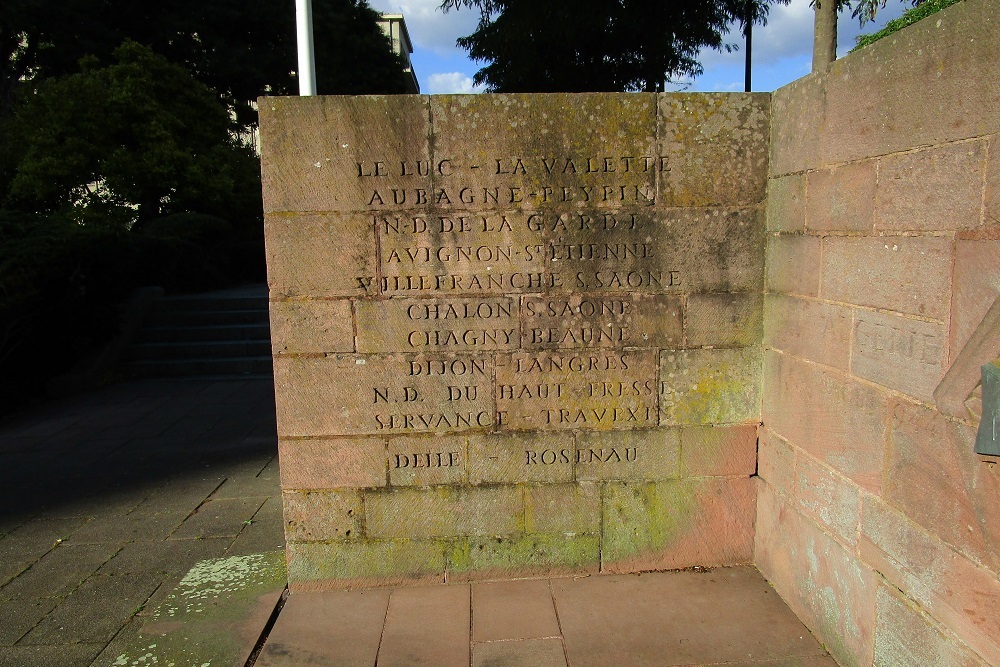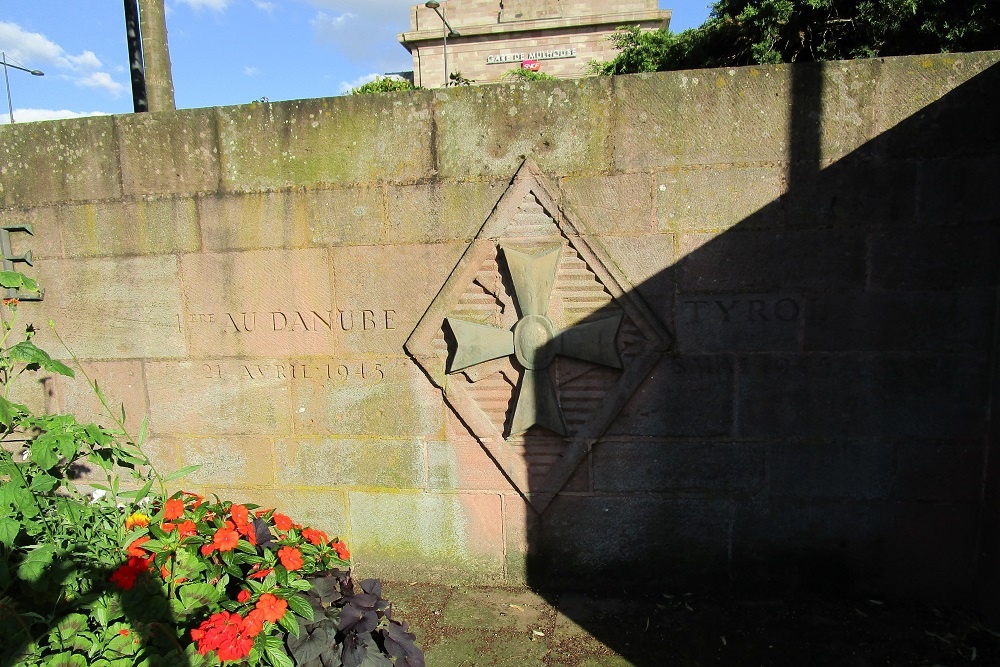Remembrance Wall 1st Armored Division
In a park in front of Mulhouse station there is a memorial wall in honor of the First Armored Division, which was part of the First French Army during the Second World War.
The division was founded on May 1, 1943 in Algeria and was led by General Touzet du Vigier.
The Division's struggle in the Second World War has three phases.
From the Mediterranean to the Vosges, 15 August - 13 November 1944
During the first part of the operations, the Division is engaged in battle, after which the whole division contributes to the creation of the beachhead, the capture of Toulon and Marseilles and the liberation of Provence. It crosses the Rhone by improvised means, regroups in less than fifteen days after landing west of the river and makes a 600-kilometer drive that will take it to the foot of the Vosges, after an uninterrupted series of victorious battles resulting in the liberation of Saint-Étienne, Lyon, Anse and Villefranche, Chalon-sur-Saône, Chagny, Beaune, Dijon and Langres. Then begins the suffering of a slow and difficult penetration through the Vosges valleys, in the mud, in the rain and the snow. After forty-five days of walking towards Le Thillot, with stations Mélisey, Servance, Château-Lambert, Ramonchamp, Cornimont, Travexin, Fresse, la Chevestraye, Recolonges, la Chapelle de Ronchamp (hill of Bourlémont), the division arrives at the edge of Alsace on October 18, 1944.
The battles for Alsace, November 14, 1944 to February 9, 1945
During the second part, the 1st Division will also be the first to enter Alsace and be first again on the Rhine. Beginning November 14 from the upper Doubs Valley, the victorious offensive of the 1st French Army broke the German apparatus of the Belfort Gorge. The division, operating as part of the 1st Army Corps (General Béthouart), arrives from Héricourt along the Swiss border and takes Delle on November 18. The next day C.C. 3 in Alsace and at 6 p.m. Lieutenant de Lois' tank platoon can baptize its pennant in the Rhine, near Rosenau. He belongs to the 4th squadron of the 2nd African Chasseur Regiment. This officer would then be killed in his tank on November 23, hit by a panzerfaust blow during the attack on the Lefevre barracks in Mulhouse. Colonel Caldairou entered that city on the 20th. But despite the success achieved at the meeting of the 1st and 2nd Army Corps in the Burnhaupt region, the enemy will manage to recover and maintain a bridgehead around Colmar. For two months, the division will hold a defense sector in the snow on the Doller, south of what will be called the Colmar pocket. On January 20, the 1st French Army departed again to attack the two northern and southern flanks of the pocket in the middle of a snowstorm. After three weeks of struggle, Alsace was finally liberated, Colmar was taken on February 2. The division, which has been fighting under the command of General Sudre since December 5, after a painful progression between the potassium mines, began a brief operation that brought it to Chalampé on the morning of February 9. She thus ended this campaign of France that began on August 15, 1944 and ended six months later on the banks of the Rhine.
Penetration in Germany, February 10 - May 7, 1945
At the beginning of the third period, from April 5, the Division was in Germany. Fighting with the 9th Colonial Infantry Division, it opened the way in the Black Forest to deliver Baden-Baden and the important Freudenstadt crossroads to the French 1st Army. After marching on Kehl and Offenburg, it plunges south into the plain of Baden and captures Friborg on April 21. He joined the division on the 28th southwest of Ulm. The 1st Armored Division did indeed cross the Rhine on April 17th. The division thus passes through Rottweil and Horb to the Danube, crosses the river on April 21 at Mulheim and Tuttlingen, and simultaneously with the completion of the encirclement of the enemy forces still fighting in the Black Forest at Stockach, it goes up road without the along the Danube via Sigmaringen to Ulm, which it occupies in collaboration with the US forces of the 7th army arriving from the north. Once again the direction of the march will change and, keeping another loophole encompassing the defeated German army, the 1st Division will move due south on the left bank of the Iller and take Immenstadt on April 30. and crossed the Austrian border the same day to occupy Aach and Oberstdorf. Having only mountain paths ahead of her, she gave way to the infantry and regrouped around Biberach. First on the Rhine, first on the Danube, the division on the cross of Saint-Louis completed its splendid journey after an uninterrupted series of victorious battles. It played a decisive role in the eventual success in the Black Forest and in the Baden plain. After that, the entire division fought in Germany without stopping until May 7, the date of Germany's unconditional surrender.
Do you have more information about this location? Inform us!
Source
- Text: Dick de Bruijne
- Photos: Dick de Bruijne
Related books
Nearby
Point of interest
Monument
- Memorials Central Station Mulhouse - Mulhouse
- Remembrance plaque deported homosexuals - Mulhouse
- Commemorative plaque Liberation Mulhouse - Mulhouse











